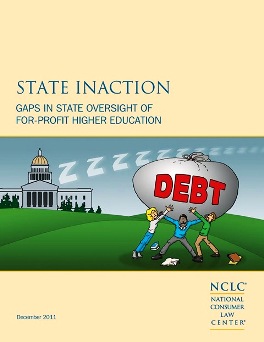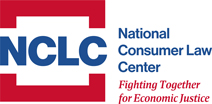Gaps in State Oversight of For-Profit Higher Education

Published Dec. 1, 2011©National Consumer Law Center
Download the full report (PDF)
Download the Executive Summary & Recommendations (PDF)
Download the State-by-State Student Relief Chart (PDF)
Download the press release (PDF)
The astronomical growth in for-profit higher education has exposed increasing numbers of students to rampant fraud and abuse. This report examines state oversight of for-profit schools, focusing on state regulatory structures and the levels of resources devoted to enforcement and oversight. The report also evaluates consumer protection laws, relief funds and other options available to assist students who are harmed.
There are promising signs that some states are starting to exercise their legal authority to rein in for-profit school abuses and provide relief for students, but much more needs to be done. The report concludes with 14 recommendations to assist states that wish to better protect students and taxpayers.
The Bad News
1. Common problems with for-profit post-secondary schools include:
Inflated or misleading job placement rates
Manipulation of student grades and attendance records and
Illegal recruitment practices
2. In overseeing for-profit schools, many states:
Lack appropriate staffing levels
Have diluted and/or disparate resources
Have conflicts of interest (e.g. members of the for-profit school industry comprise the majority of the supervisory board)
Lack adequate funds that are dedicated to oversight and enforcement and
Fail to provide easily accessible public information about schools (e.g. process to register complaints)
Consequently, state oversight and enforcement of students harmed by for-profit post-secondary schools has been dismal to date.
The Good News
1. Some states are doing a better job of oversight and enforcement, even with limited resources.
2. Many states have relief funds for defrauded students collected from for-profit schools who operate in the state.
3. Most states have substantive legal recourse against fraud and abuse by for-profit schools if they choose to employ it.
Every state and the District of Columbia has an unfair, deceptive acts and practices (UDAP) law
Many states have additional consumer protection laws with separate provisions targeted at for-profit schools,
including laws regarding disclosure, refund policies and prohibitions of specific practices
Federal law requires states to help regulate for-profit higher education schools that participate in the federal aid programs
Facts on States and For-Profit Higher Education Schools
State Staffing: Down for the Count
States with the highest ratio of for-profit schools to staff oversight:
Delaware (87:1)
Massachusetts (70:1)
Oklahoma (110:1)
Washington (187:1)
Wyoming (125:1)
Source: National Consumer Law Center phone survey, 2011.
Students Buried in Debt ─ Often for Life
Students at for-profit colleges are more than twice as likely to default on federal student loans as those who attend public institutions.
Source: Project on Student Debt (September 2011)
Taxpayer Dollars at Risk
In 2010-2011, 9% of student grant aid came from state governments.
Source: CollegeBoard, “Trends in Student Aid 2011.”
Additional Resources
Piling It On: The Growth of Proprietary School Loans and the Consequences for Students (January 2011)
NCLC’s Student Loan Borrower Assistance Project website
About Us
National Consumer Law Center® (NCLC®) is a non-profit organization specializing in consumer issues on behalf of low-income and other vulnerable people. Since 1969, NCLC has worked with legal services and nonprofit organizations as well as government and private attorneys across the United States, to create sound public policy for low-income and elderly individuals on consumer issues.
NCLC’s Student Loan Borrower Assistance Project provides information about student loan rights and responsibilities for borrowers and advocates. The Project also seeks to increase public understanding of student lending issues and to identify policy solutions to promote access to education, lessen student debt burdens and make loan repayment more manageable. Visit www.studentloanborrowerassistance.org.
